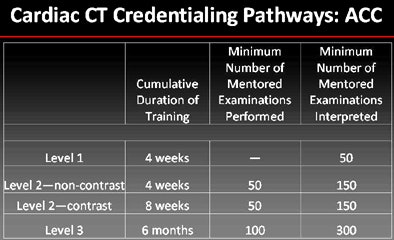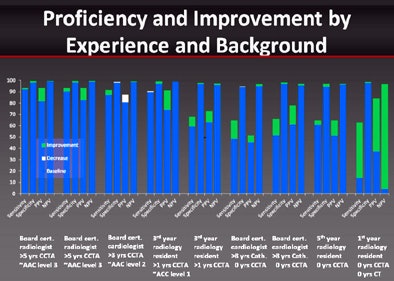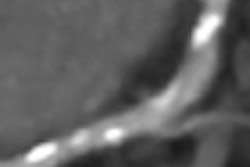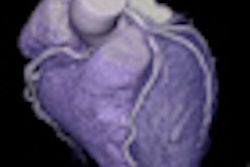
SAN FRANCISCO - Cardiac CT credentialing comes from several organizations in the U.S. and in various levels corresponding to different training and proficiency achievements. But doctors can't expect to read with the best unless they're prepared for a lot of training, a CT expert said at the International Society for Computed Tomography (ISCT) meeting.
Do we really need special credentialing for cardiac CT, given all the residency and fellowship training involved in becoming a radiologist? We really do, said Dr. U. Joseph Schoepf from the Medical University of South Carolina.
 Dr. U. Joseph Schoepf
Dr. U. Joseph Schoepf
Even with extensive training, he said, few actually achieve the high proficiency levels that are reported in the literature. And when it comes down to comparing cardiac CT readers who have been trained, a new study shows that experience, especially in cross-sectional imaging, trumps other factors in determining reader proficiency.
Anyone who wants to read cardiac CT needs special training, he said.
"The truth is that cardiac CT is the new kid on the block for many practitioners who finished their training more than a decade ago," Schoepf said. Cardiac CT is growing rapidly, but even today "there aren't enough institutions out there that have enough volume in cardiac CT to really appropriately train residents and fellows."
Considering all the different credentialing methods out there, if practitioners expect to be paid for reading cardiac images, training is the only viable pathway to a paycheck. For nonradiologists, the path is even steeper because they must also become proficient in reading CT, both for accreditation purposes and to perform adequately, Schoepf said.
The following organizations offer cardiac imaging interpretation:
American College of Cardiology (ACC)
The American College of Cardiology (ACC) provides accreditation in proficiency levels ranked level I to level III. Level I, the entry level for interpreting clinical studies, requires a minimum of 50 mentored cardiac CT exams along with a minimum of four weeks of training, with higher levels requiring longer training and more cases, Schoepf said.
 |
| The ACC requires increasingly stringent reading and training requirements for successive credentialing levels. All images courtesy of Dr. Joseph Schoepf. |
ACC credentialing is generally administered through the Society of Cardiovascular Computed Tomography (SCCT), Schoepf said.
Certification Board of Cardiovascular Computed Tomography (CBCCT)
The CBCCT, an organization supported by multiple medical societies, is another pathway to cardiac CT interpretation, Schoepf said. The exam, next scheduled for September 19 and 20, is a multiple choice test that lasts about 4.5 hours and is offered at professional testing centers throughout the U.S. It is a multiple choice test with some image material.
American College of Radiology (ACR)
The ACR's accreditation program is based on the ACR-North American Society for Cardiovascular Imaging (NASCI)-Society for Pediatric Radiology (SPR) practice guidelines for performing and interpreting cardiac CT, which can be accessed on the ACR's website, Schoepf said.
For practitioners with a radiology background, ACR requires 30 hours of CME in cardiac imaging and, like the ACC, interpretation of 50 cardiac CT exams.
But for physicians with nonradiology backgrounds, the road is harder. ACR guidelines for diagnostic CT "actually come down pretty heavy on the requirements in terms of experience with cross-sectional CT of the chest or other structures before individuals can be considered credentialed to perform cardiac CT," Schoepf said.
Nonradiologists are required to complete 200 hours of Category 1 CME in the performance and interpretation of CT. In addition, the applicant must supervise, interpret, and report 500 cases, at least 100 of which must be a combination of thoracic CT or thoracic CT angiography, he said.
The pinnacle of cardiac CT credentialing through the ACR is known as CoAP, or the Certificate of Advanced Proficiency, which is offered at the new Reston, VA, educational facility, according to Schoepf.
"This is actually a rather challenging test that consists of a multiple-choice portion, and also challenges the practitioner with real-life cardiac CT cases that need to be interpreted on a workstation, and makes up a substantial portion of overall score," he said. "It's probably the most challenging exam out there in the realm of cardiac CT."
How well does training work?
What does interpretation of 50 mentored cases get a reader in terms of proficiency? It means different things for different readers, but there is always improvement, as it turns out. Schoepf said he was interested in the fact that mentored reading of 50 cases confers a license to read CT.
To test the validity of that training, the group pulled together 100 cardiac CT studies with catheter correlation. The researchers selected nine readers with varying backgrounds to initially read 50 cases to test their proficiency.
The catheter results and the cases then underwent mentored review and reinterpretation, Schoepf said. Finally, they interpreted 50 new cases and were graded on the change from the first round of 50 cases.
','dvPres', 'clsTopBtn', 'true' );" >

Click to enlarge.
Chart shows the change in interpretation levels in nine readers with varying experience levels after interpreting 50 mentored cases. The most experienced readers are on the left. After reading 50 cases, each reader had them reviewed and reinterpreted by an expert reader using unblinded angiography results, followed by 50 new cases to gauge improvement. All readers improved after training, but not equally.
In the results shown on the graph above, only the most experienced readers performed at levels commensurate with performance of cardiac CT in the literature, he said.
All of the readers, even the most experienced, improved after training. But the improvement wasn't uniform, Schoepf said.
The three least experienced readers (right of chart) are a case in point: cardiologists with a disease-specific reading background but little cross-sectional imaging experience who performed poorly on the imaging test.
Cardiologists "actually performed substantially worse than some of the radiology residents who also had very limited cardiac CT experience but came from a background of cross-sectional imaging," he said.
The study concluded that experience is the strongest determinant of proficiency in cardiac CT interpretation, and it also showed that cross-sectional imaging experience is slightly more important than disease-specific experience, Schoepf said.
There is also clearly a need for dedicated CT training that is longer in duration than current requirements, he added. Only the most experienced readers are performing at state-of-the-art levels.
"For ensuring quality in cardiac CT interpretation across the healthcare system, I think demonstration of competency at a higher level -- for instance, the CoAP exam provided by the ACR -- is desirable," he said.




















